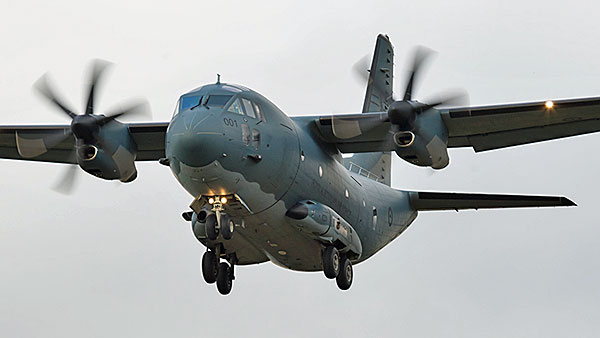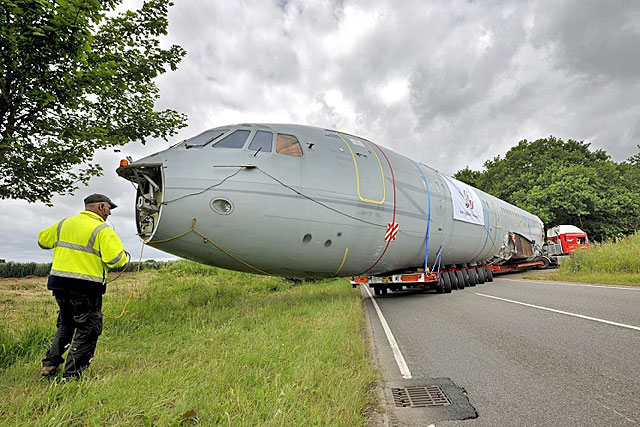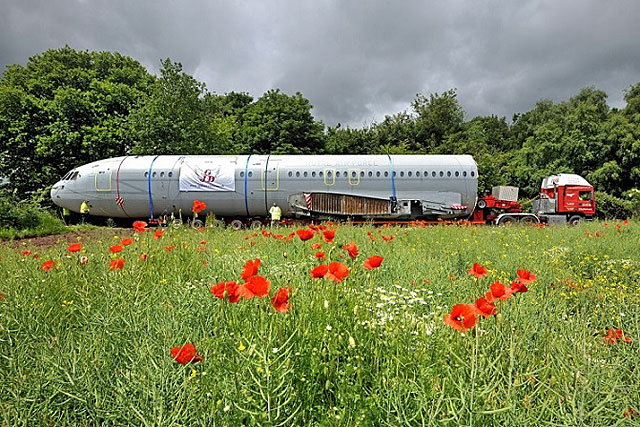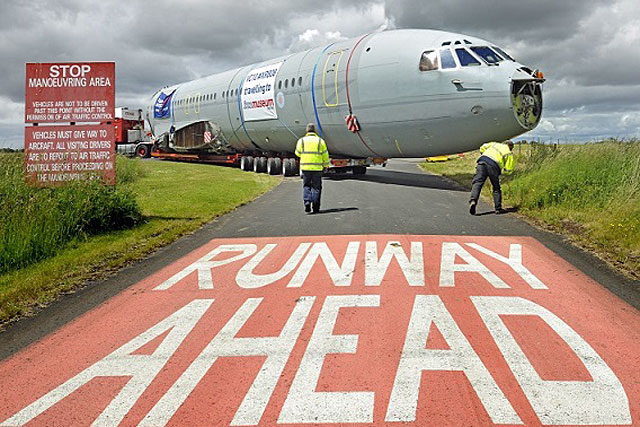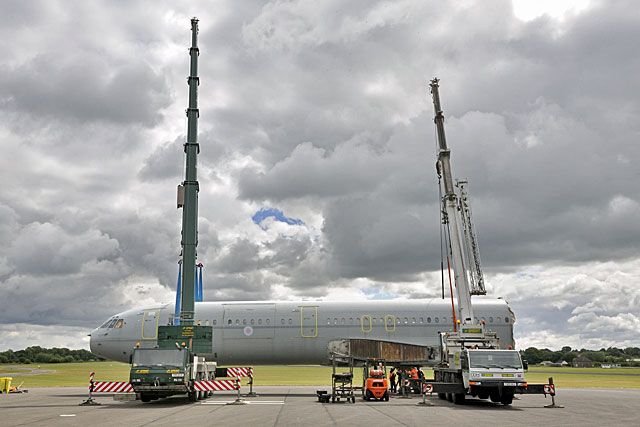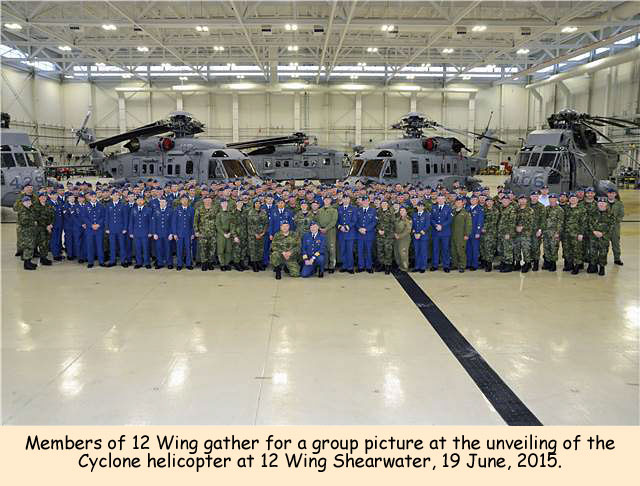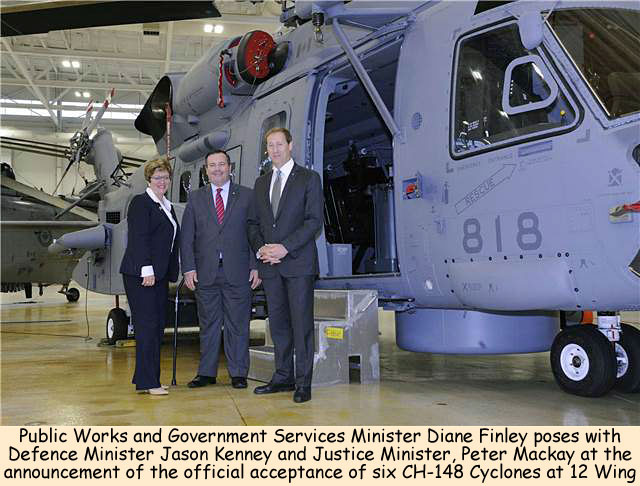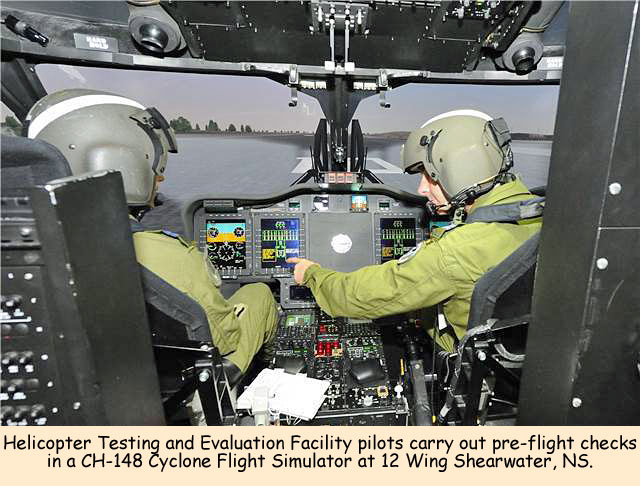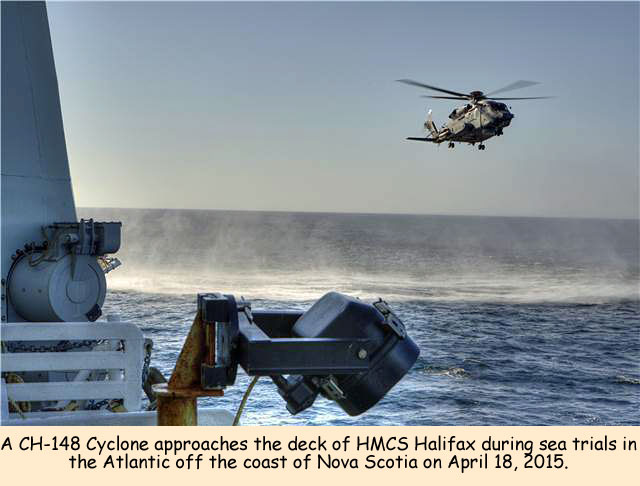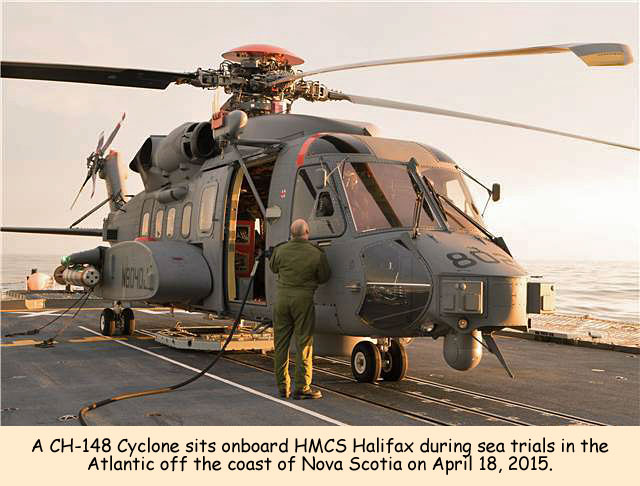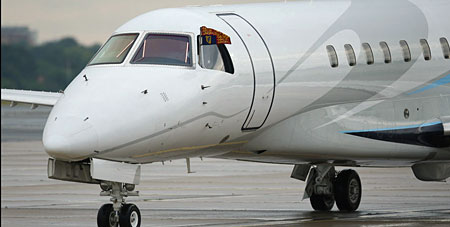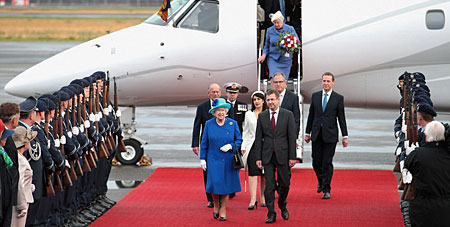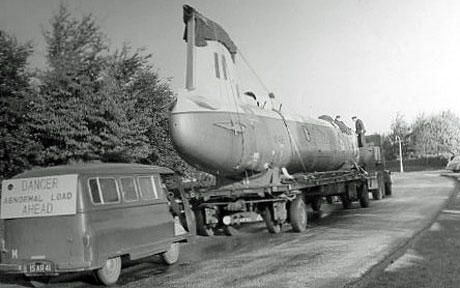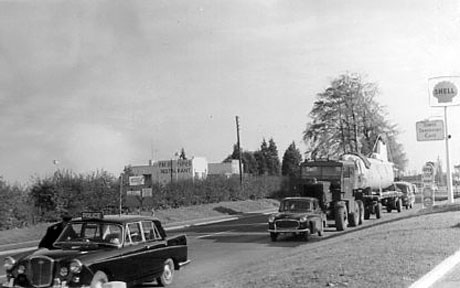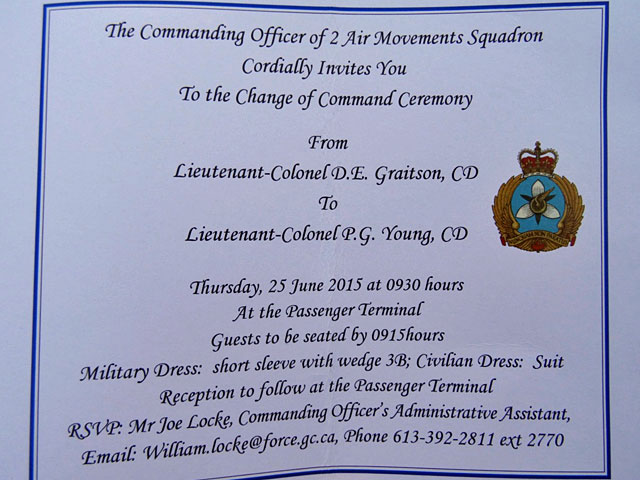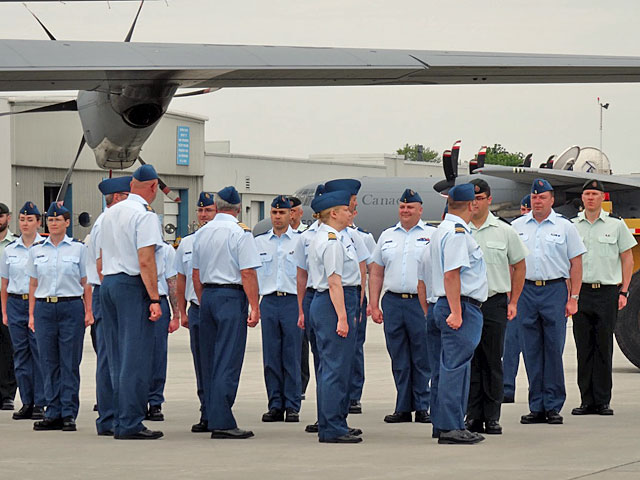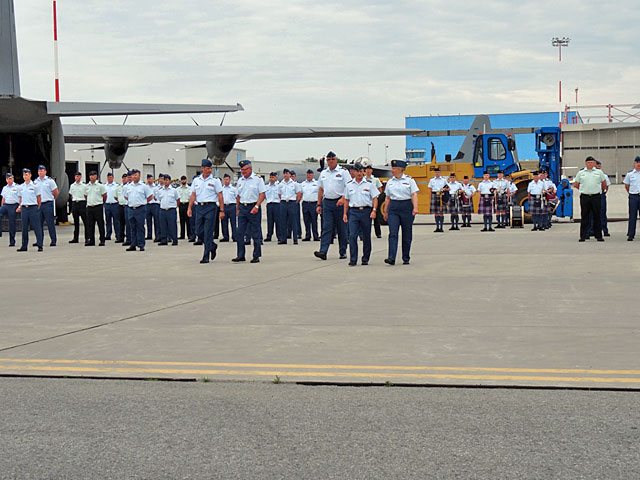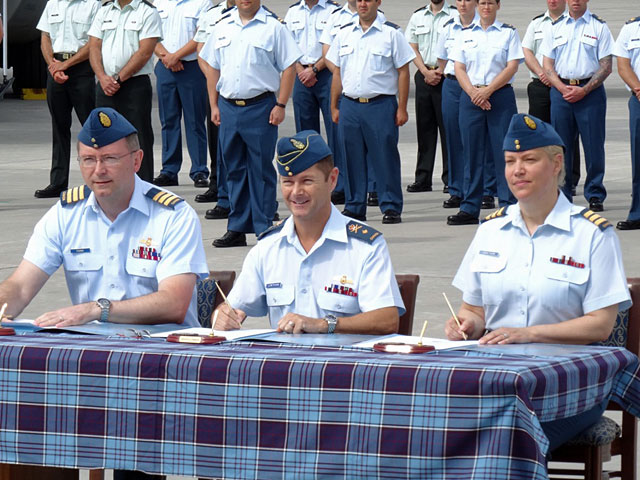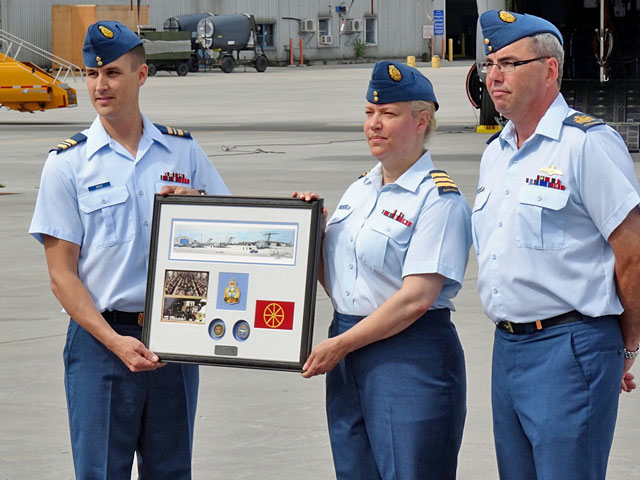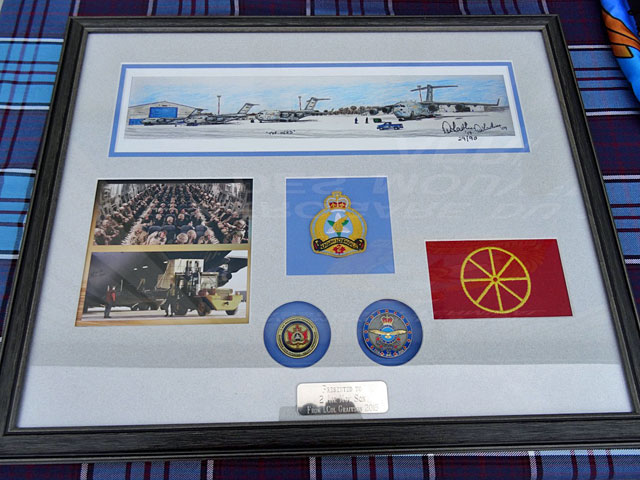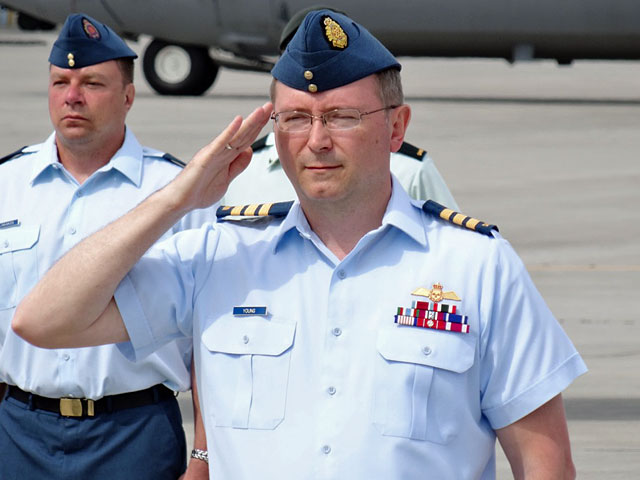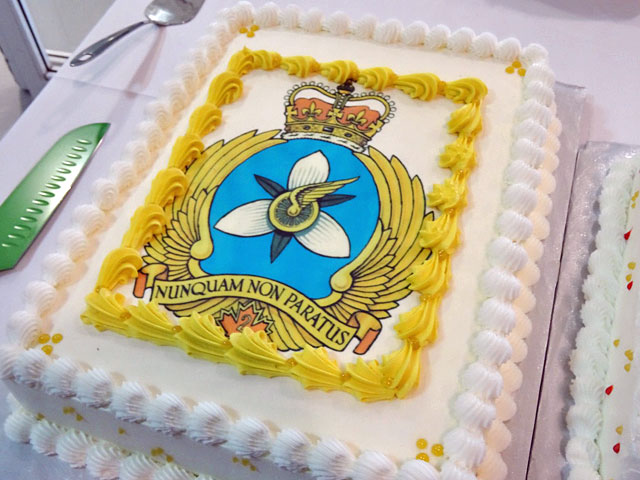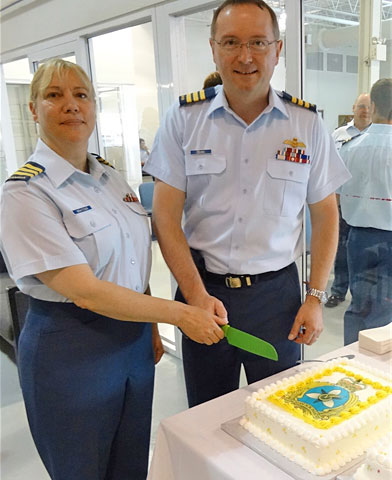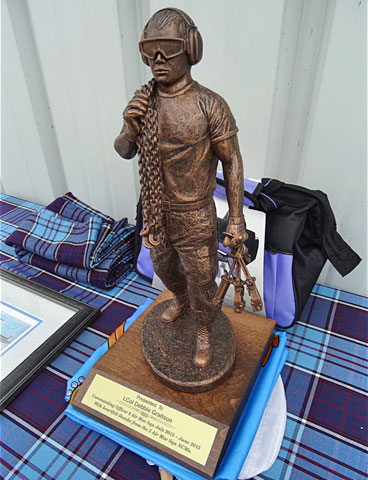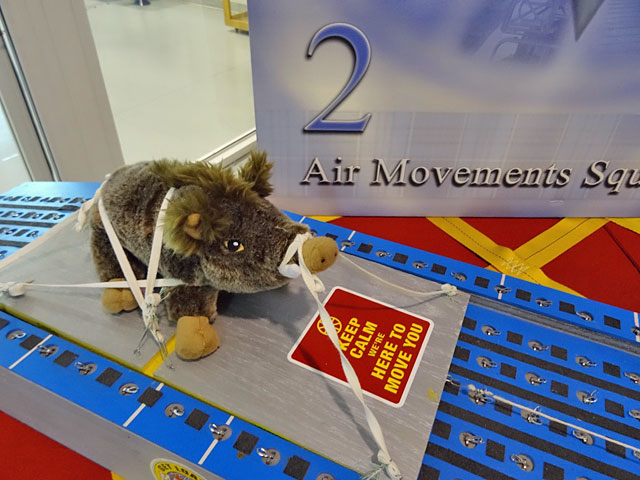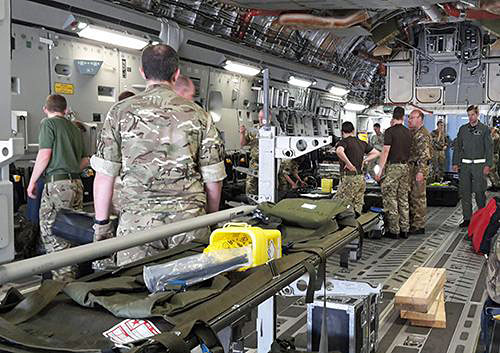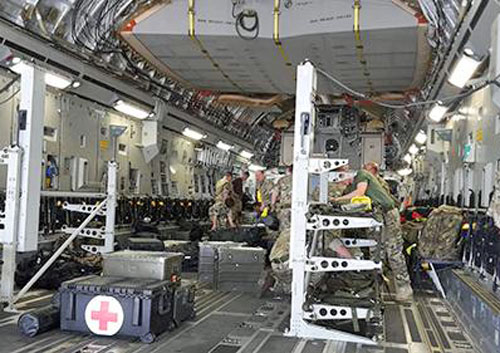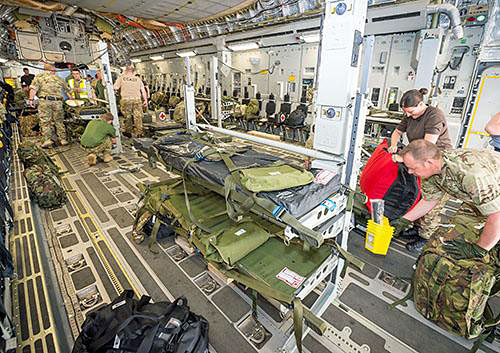
First RAAF C-27J touches down
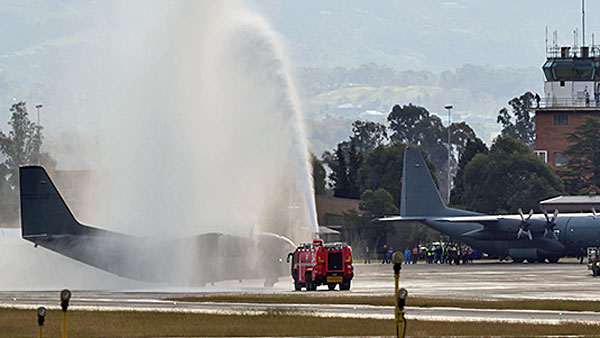
The first of 10 Alenia C-27J Spartan tactical airlifters for the RAAF has touched down at its new home of RAAF Base Richmond.
The aircraft, A34-001, landed at Richmond at approximately 3:45 on Thursday afternoon at the end of the last leg of its delivery flight from prime contractor L-3’s Waco, Texas facility, where it departed on June 15. A second C-27J, A34-002, is expected to be delivered to Richmond in August.
A34-001 had entered Alenia Aermacchi’s Turin assembly line in December 2012 and first flew on December 18 2013.
The aircraft, A34-001, landed at Richmond at approximately 3:45 on Thursday afternoon at the end of the last leg of its delivery flight from prime contractor L-3’s Waco, Texas facility, where it departed on June 15. A second C-27J, A34-002, is expected to be delivered to Richmond in August.
A34-001 had entered Alenia Aermacchi’s Turin assembly line in December 2012 and first flew on December 18 2013.
It was ferried to L-3 in Waco in March 2014 for fitment of its ballistic protection matting, EW/self-protection systems, and communications suite. The RAAF then accepted the first two C-27J Spartans onto the Commonwealth register, and commenced training on the aircraft at L-3’s facility at Waco, last December.
The C-27Js are being acquired as battlefield airlifters to replace the capability lost with the retirement of the DHC-4 Caribou in 2009. Ultimately the C-27Js will be based at Amberley.
Australian Aviation
The C-27Js are being acquired as battlefield airlifters to replace the capability lost with the retirement of the DHC-4 Caribou in 2009. Ultimately the C-27Js will be based at Amberley.
Australian Aviation
From: Gus Turney, Chippenham
Sent: Monday, June 15, 2015 11:52 AM
Subject: Better late than never... a couple of stories.
Hi Tony,
The first story relates to being pressed into service. In June 1984 I was chosen to be a member of the Volant Rodeo Airlift Competition Team, which took place at Pope AFB, in North Carolina. My role was to be as a travelling reserve within the Engines Running Offload (ERO) team to step in if any of the other team members had cause to drop out. The regular team members were FS Colin Allen, Sgt Nobby Clarke, SAC Andy Hodgson and SAC Scouse Leman. I had participated in all the training, including a couple of days at Mildenhall, so I felt confident about my role.
On arrival at Pope, we were transported by bus to our accomodation at the Heart of Fayetville Hotel and Apartments. I was to share a very spacious and comfy condo with Scouse for the next fortnight. Coincidentally, the Aussie team were also at the same hotel and they had bought with them a cargo igloo full of cans of beer, deciding that this was a higher priority than aircraft spares!
During the detachment, a trio of senior officers were due to visit from Washington. As I was free I was nominated to pick up the officers from the regional airport, south of Fayetville, and chauffeur them to Pope AFB in the opulent luxury of our huge Lincoln (might have been a Cadillac) hire car. I got to the airport in good time, and picked up the Group Captain and two Wing Commanders. Now I don't know wether it was due to the officers asking me lots of questions, but I somehow got distracted, took a wrong turning, and ended up heading south on I-95. What should have been a 30 minute journey north through Fayetville, ended up taking 3 hours, while I tried to turn off the Interstate, and find my bearings. Remember, this is the age before Satnavs and smartphones. I eventually joined the officers up with the Detcom, Wing Commander Warsap, and sloped off, hot, sweaty and thirsty. To this day, I don't know if those officers cottoned on to the fact that I was lost, and only pretended to be cool, calm and nonchalant!
Sent: Monday, June 15, 2015 11:52 AM
Subject: Better late than never... a couple of stories.
Hi Tony,
The first story relates to being pressed into service. In June 1984 I was chosen to be a member of the Volant Rodeo Airlift Competition Team, which took place at Pope AFB, in North Carolina. My role was to be as a travelling reserve within the Engines Running Offload (ERO) team to step in if any of the other team members had cause to drop out. The regular team members were FS Colin Allen, Sgt Nobby Clarke, SAC Andy Hodgson and SAC Scouse Leman. I had participated in all the training, including a couple of days at Mildenhall, so I felt confident about my role.
On arrival at Pope, we were transported by bus to our accomodation at the Heart of Fayetville Hotel and Apartments. I was to share a very spacious and comfy condo with Scouse for the next fortnight. Coincidentally, the Aussie team were also at the same hotel and they had bought with them a cargo igloo full of cans of beer, deciding that this was a higher priority than aircraft spares!
During the detachment, a trio of senior officers were due to visit from Washington. As I was free I was nominated to pick up the officers from the regional airport, south of Fayetville, and chauffeur them to Pope AFB in the opulent luxury of our huge Lincoln (might have been a Cadillac) hire car. I got to the airport in good time, and picked up the Group Captain and two Wing Commanders. Now I don't know wether it was due to the officers asking me lots of questions, but I somehow got distracted, took a wrong turning, and ended up heading south on I-95. What should have been a 30 minute journey north through Fayetville, ended up taking 3 hours, while I tried to turn off the Interstate, and find my bearings. Remember, this is the age before Satnavs and smartphones. I eventually joined the officers up with the Detcom, Wing Commander Warsap, and sloped off, hot, sweaty and thirsty. To this day, I don't know if those officers cottoned on to the fact that I was lost, and only pretended to be cool, calm and nonchalant!
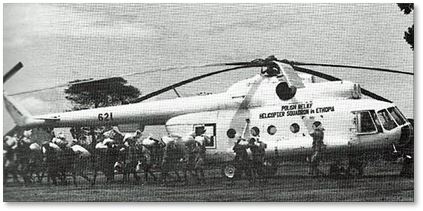
The second story is about working with foreign military during my first stint on Op Bushel in Ethiopia.
I took advantage of a day off, to go up country and assist 47AD as part of the drop zone party. We were to be conveyed to the Meranya DZ by a Polish Mi-8 helicopter.
We met up with the Polish crew at Lidetta military airfield, on the west side of Addis Ababa, and were invited to join them for "breakfast". This consisted of a selection of cold meats, bread, and coffee.
I took advantage of a day off, to go up country and assist 47AD as part of the drop zone party. We were to be conveyed to the Meranya DZ by a Polish Mi-8 helicopter.
We met up with the Polish crew at Lidetta military airfield, on the west side of Addis Ababa, and were invited to join them for "breakfast". This consisted of a selection of cold meats, bread, and coffee.
It was only when I sat at the table that I noticed the bottle of vodka positioned in the middle. Our Polish host poured us a generous shot, and called a toast. After a speech and two more toasts, it was decided that we should get going.
The 45 minute trip to the DZ was uneventful, gyrating our way through the thin air over truly spectacular scenery. I tried to overlook the fact that we had a large internal fuel tank which was leaking fumes, and that the the two pilots up front were both smoking! It was a long, hot but rewarding day up on the DZ, but that's another story. Upon return to Addis we enjoyed a farewell vodka before retiring to the Ethiopian version of Fawlty Towers (aka The Ghion Hotel). I have attached a scanned picture of the actual helicopter that I travelled in.
Photo credit to Molly O'Loughlin White, from her splendid book, “The Foodbirds".
Cheers,
Gus Turney (Lima Team 83-85)
The 45 minute trip to the DZ was uneventful, gyrating our way through the thin air over truly spectacular scenery. I tried to overlook the fact that we had a large internal fuel tank which was leaking fumes, and that the the two pilots up front were both smoking! It was a long, hot but rewarding day up on the DZ, but that's another story. Upon return to Addis we enjoyed a farewell vodka before retiring to the Ethiopian version of Fawlty Towers (aka The Ghion Hotel). I have attached a scanned picture of the actual helicopter that I travelled in.
Photo credit to Molly O'Loughlin White, from her splendid book, “The Foodbirds".
Cheers,
Gus Turney (Lima Team 83-85)
UK clears A400M for training flight resumption
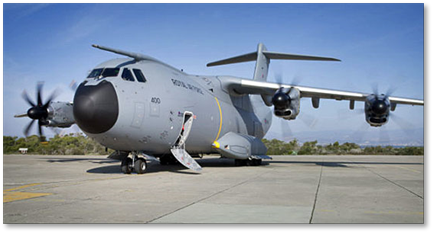
The UK Royal Air Force is to resume training flights with its first pair of Airbus A400M tactical transports “with immediate effect”, the service announced on 16 June.“Having undertaken and completed a series of thorough checks on the UK’s A400M aircraft and how it is operated, the RAF is now satisfied that the additional processes and procedures introduced means it is now safe to resume flying,” the service says.Flight operations with the UK’s lead Atlas airlifters had been paused since a fatal accident in Seville, Spain on 9 May, which killed four Airbus flight-test personnel. Shortly after the loss, the manufacturer advised operators of the type to perform electronic control unit checks on each of its Europrop International TP400-D6 engines.
Ground-based training and simulator-based instruction had been performed for RAF personnel at its Brize Norton base in Oxfordshire while flight operations were suspended.
Flightglobal.com
Flightglobal.com
From: Karen Dierijck, Trenton, ON
Date: 6/15/2015, 7:51 am, EDT
Subject: Guest Book Entry - RCAF Mystery Photo 112913
Date: 6/15/2015, 7:51 am, EDT
Subject: Guest Book Entry - RCAF Mystery Photo 112913
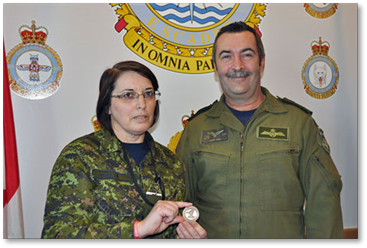
On Friday, 22 Mar 13, MCpl Karen Dierijck, 8 AMS Flight Safety Investigator / Administrator, received the Air Reserve Coin from BGen Reid for her dedication and commitment to the 8 Air Movement Squadron (AMS) Flight Safety Program and for her untiring community involvement.
VC10 Arrival at Cosford
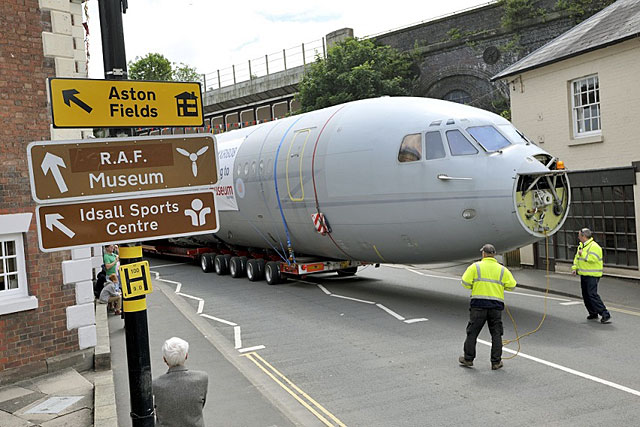
The Royal Air Force Museum Cosford is pleased to announce that its latest acquisition, VC10 serial number XR808 has now arrived at Cosford, following a final road trip along the M6 motorway. After a successful eight month dismantling process carried out by GJD Services, a specialist maintenance and aircraft salvage company based at Bruntingthorpe, Leicestershire, the VC10 finally arrived at Cosford on Sunday 21 June. The 93ft long fuselage departed from Bruntingthorpe early on the Sunday morning and arrived at Cosford shortly after 1.00pm. Transported on a low loader lorry, the route saw the aircraft pass along the M69, M6 and the M54 to Cosford, via the nearby village of Shifnal. Too large to pass under the railway bridge at Cosford, the fuselage made its way to Junction 4 on the M54 and through Shifnal, with some tricky manoeuvring en route, before heading onto the airfield at RAF Cosford.
Sqn Ldr Chris Wilson, Media, Communication and Co-ordination Officer at RAF Cosford said: “Having flown on VC10s throughout my career I’ve been looking forward to seeing this one arrive at RAF Cosford. The VC10 has been an iconic RAF aircraft for so many decades that it seems fitting that XR808 finally comes to rest at the RAF Museum at the end of its exemplary service. RAF Cosford is the Home of RAF Engineering so it is apt that the VC10 comes to our airfield to be rebuilt prior to going on permanent display at the Museum.”
The VC10 wings and tail plane will be transported on 28 June and work will then commence on the rebuild. Throughout July a team of engineers from GJD Services will unload the aircraft, position and trestle the inner wings before attaching them to the fuselage. Early August the aircraft will transfer from the RAF Cosford airfield to the Museum site for the final reassembly, which will take place directly outside the Museum’s Hangar 1.
The VC10 wings and tail plane will be transported on 28 June and work will then commence on the rebuild. Throughout July a team of engineers from GJD Services will unload the aircraft, position and trestle the inner wings before attaching them to the fuselage. Early August the aircraft will transfer from the RAF Cosford airfield to the Museum site for the final reassembly, which will take place directly outside the Museum’s Hangar 1.
Once on the Museum’s site, the wings will be rebuilt and the rear fuselage section attached. By late September the team anticipates to be fitting the fin and tail plane ready to install the engines, nacelles and outer wings. The final finishing touches of refitting the access panels and a little paint work touch up will be carried out late October before the fully reassembled VC10 is moved into its final position next to the Lockheed Hercules C130K Mk3, where the aircraft will go on public display.
Gary Spoors, Accountable/Engineering Manager at GJD Services said:“When GJD were asked to move XR808 on behalf of the RAF Museum we were very keen to take on the challenge; to play our part in preserving this icon of British Engineering. Whist we were fully aware of the scope of the challenge presented to us, it has tested our engineering skills. Working as a team we have come up with some innovative solutions to problems as they arose, all of which we have overcome.
"Personally, I have a great affiliation with the VC10, having worked on the type throughout various stages of my career and I wanted to ensure that XR808 was dismantled and moved with care and precision. We chose to reverse engineer the aircraft, de-riveting the various section, wing, fin, tail and back end, in order to avoid any cuts which we felt would compromise the integrity and beauty of the aircraft. An enormous effort has gone into the dismantling of XR808 and we are very pleased with progress the GJD team has made so far. We are looking forward to the next phase and seeing XR808 complete in her new home.”
"Personally, I have a great affiliation with the VC10, having worked on the type throughout various stages of my career and I wanted to ensure that XR808 was dismantled and moved with care and precision. We chose to reverse engineer the aircraft, de-riveting the various section, wing, fin, tail and back end, in order to avoid any cuts which we felt would compromise the integrity and beauty of the aircraft. An enormous effort has gone into the dismantling of XR808 and we are very pleased with progress the GJD team has made so far. We are looking forward to the next phase and seeing XR808 complete in her new home.”
The VC10 was a British aircraft originally built by Vickers-Armstrong and then later by the British Aircraft Corporation and entered service with Royal Air Force in 1966. This dual-role aircraft enabled the rapid deployment of troops and their weaponry and fast jet aircraft to many theatres of operations around the world. With the ability to carry up to 124 troops at a time with nine crew members or a freight load of up to 20,400kgs the VC10 has been one of the RAF’s most significant assets for nearly 50 years. The RAF VC10’s allowed true global mobility offering a combination of speed and range never previously attained by an RAF Transport Command aircraft type.
Ian Thirsk, Head of Collections at the RAF Museum said: “The BAC VC-10 formed the mainstay of the RAF’s long range strategic transport force for almost fifty years. For one aircraft type to have been in service for such a long period is remarkable in itself. However, when this is added to the variety of roles and worldwide scope of operations, it is clear this is a unique aircraft and it would not be possible to accurately portray the history of the RAF without an example of the type - therefore it is essential that such a pivotal and long serving aircraft is preserved by the RAF Museum.”
Darren Priday, Conservation Centre Manager at the RAF Museum said: “I completed two tours on VC10’s during my RAF career, totalling 6½ years on type, so I am looking forward to being reacquainted with an old friend. Renown for being a troop carrier the VC10 also excelled in other roles - carrying freight, aero-med, VIP duties and air-to-air refuelling. ‘BOB’, will be a great addition to the RAF Museum Cosford site.”
For further information about the Museum, please visit the Museum website www.rafmuseum.org or call 01902 376200. The Museum is open daily from 10am and entry to the Museum is FREE of charge.
warbirdsnews.com
For further information about the Museum, please visit the Museum website www.rafmuseum.org or call 01902 376200. The Museum is open daily from 10am and entry to the Museum is FREE of charge.
warbirdsnews.com
From: Alex Masson, Chelmsford
Sent: Thursday, June 25, 2015 6:22 PM
Subject: Turbulence!
Tony,
Saturday the 23rd February 1957 - Christmas Island - Building up for the Hydrogen Bomb tests in May and June of that year. We were flying from Christmas Island to Australia placing Oxygen cylinders at various staging posts, Canton Island (Central Pacific) on this occasion and a 3,800 lbs Air Cooling trolley for Fiji for the anticipated arrival of the Canberras and Valiant Bombers.
Hastings WD489 belonged to 24c Squadron from Lyneham/Colerne. The letter ‘c’ denoted the fact it was a ‘Commonwealth Squadron’ with a Canadian Captain, UK Co-pilot, UK Navigator, Australian Flight Engineer, New Zealand Signaller, and a UK Air Quartermaster.
Sent: Thursday, June 25, 2015 6:22 PM
Subject: Turbulence!
Tony,
Saturday the 23rd February 1957 - Christmas Island - Building up for the Hydrogen Bomb tests in May and June of that year. We were flying from Christmas Island to Australia placing Oxygen cylinders at various staging posts, Canton Island (Central Pacific) on this occasion and a 3,800 lbs Air Cooling trolley for Fiji for the anticipated arrival of the Canberras and Valiant Bombers.
Hastings WD489 belonged to 24c Squadron from Lyneham/Colerne. The letter ‘c’ denoted the fact it was a ‘Commonwealth Squadron’ with a Canadian Captain, UK Co-pilot, UK Navigator, Australian Flight Engineer, New Zealand Signaller, and a UK Air Quartermaster.
Soon after we were airborne the Captain called, “Anyone in my crew play chess?” - I didn’t answer immediately but waited thinking, he’s come all the way from the UK with this crew, and the only fresh crew are the Servicing Corporal and me. We were both sitting in the back of the plane along with the two passengers, but as they had no headphones, the Air Quartermaster came back and asked them the same question.
I looked at the Corporal and he shook his head as the Captain repeated “I say again, Captain here, anyone in my crew play chess?” I flicked my mike and said, “Your loader here Sir! I know the moves!”
The reply came back immediately, “Oh Good! Come for’ard!” So I made my way up to the flight deck to join Flt/Lt Sproule, the Captain. He waved me closer and turning to the co-pilot waved at him to go back and sit in my seat. He in turn, protested loudly, saying, “But I have to do my ‘con-training’!” (continuous or continuing training as a pilot) The old man, as we called him, a wonderful character and a thorough ‘gentleman’, ex- WW2 Bomber pilot who had flown throughout the war and wore the DFC, ignored his protestations saying, “You’ve got all your service to complete your training, go back!”
I looked at the Corporal and he shook his head as the Captain repeated “I say again, Captain here, anyone in my crew play chess?” I flicked my mike and said, “Your loader here Sir! I know the moves!”
The reply came back immediately, “Oh Good! Come for’ard!” So I made my way up to the flight deck to join Flt/Lt Sproule, the Captain. He waved me closer and turning to the co-pilot waved at him to go back and sit in my seat. He in turn, protested loudly, saying, “But I have to do my ‘con-training’!” (continuous or continuing training as a pilot) The old man, as we called him, a wonderful character and a thorough ‘gentleman’, ex- WW2 Bomber pilot who had flown throughout the war and wore the DFC, ignored his protestations saying, “You’ve got all your service to complete your training, go back!”
A very begrudging, very young Pilot Officer did as he was told and I slipped into the co-pilot’s seat.
Flt Lt Sproule produced a pocket size travelling chess set, put it between our seats on the throttles console and we played chess. This continued on each leg of our journey to Edinburgh Field in Australia.
We landed at Canton, unloaded the Oxygen cylinders, re-fuelled and were off again in a very short space of time. The Air Cooling Trolley was still with us, destined for Fiji.
Once airborne and back on course at our cruising height of 10,000 feet I was called forward again by the Captain to continue our game.
An hour or more later I could see clouds ahead on the horizon and as we approached they got bigger and bigger and blacker and blacker. Not a pretty sight! Our Captain had also noticed this threateningly darkening sky and after consultation with our Navigator altered course to port in an effort to get around this storm. Bear in mind we had no forward looking radar with which to warn us of such weather.
Although we had veered off, way to the left away from the centre of the maelstrom, it was too big to avoid completely. Soon we were entering cloud, light and wispy at first on the outer fringes of the storm. From our height of 10,000 feet we could look up and see the immense mass of black boiling cloud towering twenty, thirty, forty thousand feet or more above us. Gradually the cloud thickened and we began to bump and sway. Gently at first but the turbulence slowly began to increase.
Flt Lt Sproule produced a pocket size travelling chess set, put it between our seats on the throttles console and we played chess. This continued on each leg of our journey to Edinburgh Field in Australia.
We landed at Canton, unloaded the Oxygen cylinders, re-fuelled and were off again in a very short space of time. The Air Cooling Trolley was still with us, destined for Fiji.
Once airborne and back on course at our cruising height of 10,000 feet I was called forward again by the Captain to continue our game.
An hour or more later I could see clouds ahead on the horizon and as we approached they got bigger and bigger and blacker and blacker. Not a pretty sight! Our Captain had also noticed this threateningly darkening sky and after consultation with our Navigator altered course to port in an effort to get around this storm. Bear in mind we had no forward looking radar with which to warn us of such weather.
Although we had veered off, way to the left away from the centre of the maelstrom, it was too big to avoid completely. Soon we were entering cloud, light and wispy at first on the outer fringes of the storm. From our height of 10,000 feet we could look up and see the immense mass of black boiling cloud towering twenty, thirty, forty thousand feet or more above us. Gradually the cloud thickened and we began to bump and sway. Gently at first but the turbulence slowly began to increase.
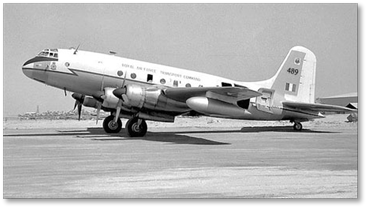
The Captain closed the chess set and indicated for me to go back to my position in the back of the aircraft. I did so and told the young Co-pilot he was wanted back on the flight deck. I took up my seat again and fastened my seat belt as the buffeting was getting worse. It continued to get worse and I noticed that with the more violent bumps our 3,800 lbs “cooling trolley” was beginning to dance on its springs.
By lashing it down with chain and strainers when we loaded it I had compressed the springs as much as I could. That was OK for normal flight in smooth conditions, but now, with the violent bumping the springs were being subjected to heavier loading and being compressed even more by the ‘g’ force with the result that the chains were holding tight one minute then being slackened the next. When the pressure bore down the loose chains clanked and groaned and jerked alarmingly. My immediate thoughts were, if this gets worse we could burst a chain and once one goes others would follow. The breaking strain of our chains was one ton, 2,240lbs but we had a 3,800lb load and this weight would increase dramatically as the ‘g’ force kicked in.
By lashing it down with chain and strainers when we loaded it I had compressed the springs as much as I could. That was OK for normal flight in smooth conditions, but now, with the violent bumping the springs were being subjected to heavier loading and being compressed even more by the ‘g’ force with the result that the chains were holding tight one minute then being slackened the next. When the pressure bore down the loose chains clanked and groaned and jerked alarmingly. My immediate thoughts were, if this gets worse we could burst a chain and once one goes others would follow. The breaking strain of our chains was one ton, 2,240lbs but we had a 3,800lb load and this weight would increase dramatically as the ‘g’ force kicked in.
More lashings, I thought! I must get more lashings on this ‘brute’! Luckily, there was plenty of spare chain and strainers at the back of the aircraft, all neatly clipped to the aircraft ribs.
I left my seat, grabbed handfuls of chain and strainers and with difficulty started adding more lashings from the floor points to the ‘trolley’. The buffeting was now almost continuous so I worked fast chaining and cranking up the strainers. Lying alongside and reaching underneath the trolley I was able to tighten more of the strainers as the springs compressed but had to mind my fingers as the chains snapped back under tension holding the load again.
Seeing our predicament the Servicing Corporal got down alongside me to assist and together we added more and more chain. By now the cloud was black - black as night and it was becoming difficult to see what we were doing except that the darkness was now being punctuated by vivid blue lights which illuminated the inside of the aeroplane.
I left my seat, grabbed handfuls of chain and strainers and with difficulty started adding more lashings from the floor points to the ‘trolley’. The buffeting was now almost continuous so I worked fast chaining and cranking up the strainers. Lying alongside and reaching underneath the trolley I was able to tighten more of the strainers as the springs compressed but had to mind my fingers as the chains snapped back under tension holding the load again.
Seeing our predicament the Servicing Corporal got down alongside me to assist and together we added more and more chain. By now the cloud was black - black as night and it was becoming difficult to see what we were doing except that the darkness was now being punctuated by vivid blue lights which illuminated the inside of the aeroplane.
Our Hastings was being tossed about mercilessly and the noise of the clanking chains and the scream of the metal as they took the strain was quite frightening. Blue lights were dancing everywhere! I was frightened! Very frightened! I kept thinking, if this load breaks loose it will go right through the side of this aeroplane! This prompted me to work faster. I next remember the Sergeant Air Quarter Master alongside me shouting, “More chain?” and I nodded furiously. The three of us now on the floor were being flung about as we struggled to link up more chain from the trolley to the floor. It was impossible to stand. We were reduced to crawling around the aircraft floor and frequently becoming weightless as we did so.
I remember very clearly thinking at the time that the Board of Enquiry would conclude;- “And the loss of the Hastings WD489 and it’s crew was due to the Air Movements Corporal who had failed to properly secure the load!”
Heaven knows how long it took us but eventually the trolley gave up dancing, the blue lights faded and gradually the ride became less turbulent. Suddenly the sun broke through and we were out of the cloud. I thanked the two who had helped me on the floor and we all smiled as we noticed our two passengers were distinctly off colour. One was white as a sheet and the other was a pale shade of green.
We had made it to Nandi Airport in Fiji without mishap but that was the scariest and roughest flight I have ever experienced!
Alex
I remember very clearly thinking at the time that the Board of Enquiry would conclude;- “And the loss of the Hastings WD489 and it’s crew was due to the Air Movements Corporal who had failed to properly secure the load!”
Heaven knows how long it took us but eventually the trolley gave up dancing, the blue lights faded and gradually the ride became less turbulent. Suddenly the sun broke through and we were out of the cloud. I thanked the two who had helped me on the floor and we all smiled as we noticed our two passengers were distinctly off colour. One was white as a sheet and the other was a pale shade of green.
We had made it to Nandi Airport in Fiji without mishap but that was the scariest and roughest flight I have ever experienced!
Alex
On this run we had two Supernumerary Crew, a Corporal Engine Fitter from the Servicing Team and myself. The Servicing Corporal had his tool kit with him to fix the engines if necessary as there were no qualified engineers at these places en route. We also carried two passengers for Australia, a Flight Lieutenant and a Sergeant.
Canada gets six Cyclone helicopters
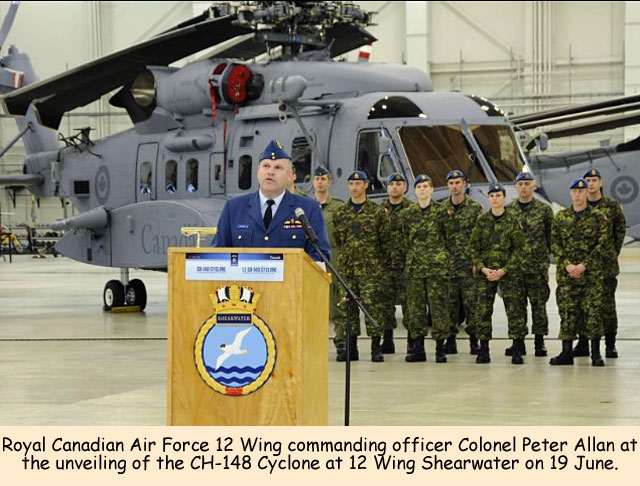
The Cyclone is replacing Canada's Sikorsky CH-124 Sea King fleet. Sea King divestment is expected to begin in 2018.
The last restructure of the programme occurred in early 2014, when Ottawa confirmed it had reached a principles of agreement with Sikorsky to begin deliveries of an interim CH-148 capability in 2015, with full operational capability by 2018. At that time the company agreed to pay damages in the amount of CAD88.6 million (USD72 million) to the Canadian government for the late delivery of the helicopters.
Jane's Defence
The last restructure of the programme occurred in early 2014, when Ottawa confirmed it had reached a principles of agreement with Sikorsky to begin deliveries of an interim CH-148 capability in 2015, with full operational capability by 2018. At that time the company agreed to pay damages in the amount of CAD88.6 million (USD72 million) to the Canadian government for the late delivery of the helicopters.
Jane's Defence
Sikorsky has delivered six CH-148 Cyclone maritime helicopters to Canada, the company announced on 19 June.
"I am confident this modern aircraft will improve our aviators' and sailors' ability to work together in defense of Canada from current and future threats," Jason Kenney, Canada's minister of national defence, said during a ceremony marking the event at the Canadian Forces' base in Shearwater.
The six helicopters were the first of 28 that Sikorsky is expected to deliver to the Canadian Armed Forces. The CH-148 was designed for anti-submarine and anti-surface warfare, search and rescue, and utility missions. Sikorsky plans to phase-in additional capabilities, while the Royal Canadian Air Force trains its pilots and maintenance personnel on the existing aircraft.
More than 40 military personnel have completed initial training, according to Sikorsky. "In parallel to the development effort, Sikorsky and our Canadian partners are committed to delivering world class, in-service support of the Cyclone to the men and women who fly and maintain the aircraft," said Bill Gostic, Sikorsky's vice president for the programme.
"I am confident this modern aircraft will improve our aviators' and sailors' ability to work together in defense of Canada from current and future threats," Jason Kenney, Canada's minister of national defence, said during a ceremony marking the event at the Canadian Forces' base in Shearwater.
The six helicopters were the first of 28 that Sikorsky is expected to deliver to the Canadian Armed Forces. The CH-148 was designed for anti-submarine and anti-surface warfare, search and rescue, and utility missions. Sikorsky plans to phase-in additional capabilities, while the Royal Canadian Air Force trains its pilots and maintenance personnel on the existing aircraft.
More than 40 military personnel have completed initial training, according to Sikorsky. "In parallel to the development effort, Sikorsky and our Canadian partners are committed to delivering world class, in-service support of the Cyclone to the men and women who fly and maintain the aircraft," said Bill Gostic, Sikorsky's vice president for the programme.
From: Andrew Spinks, Dubai
Sent: Thursday, June 25, 2015 10:33 PM
Subject: Turbulence (aka Lumpy Clouds)
Hi Tony,
I am sure we have all had a lot of experience of unpleasant lumpiness, but the worst turbulence for me was when leading F Troop in the late 70s. We were on a freighter VC10 but, without my log book which resides in a box in UK somewhere, I cannot remember where we had been or where we were going to pick up the load - we were empty at the time. However, the storm we hit was when approaching Dallas Fort Worth.
We were on the approach and had been told to sit down and strap in - we were sitting down the back at this stage. It was bumpy but suddenly the whole aircraft lurched upwards violently. All the accoutrements lifted off and came crashing down from the hat racks (my DMS shoes fell onto me; in those days we had to get off in KD and black shoes), but the most shocking sight was the female Loadmaster who had not strapped in and did an extremely good impression of zero-G astronaut training, including hitting her head on the aircraft ceiling and then coming crashing back down.
Fortunately she was not seriously hurt - just her pride. I had never seen that before, and have never done so since. But I certainly take the seat belt signs seriously now - I have witnessed what can happen if turbulence gets really bad, and the worst bump came literally out of the blue.
Regards,
Andy (currently working in Dubai)
Sent: Thursday, June 25, 2015 10:33 PM
Subject: Turbulence (aka Lumpy Clouds)
Hi Tony,
I am sure we have all had a lot of experience of unpleasant lumpiness, but the worst turbulence for me was when leading F Troop in the late 70s. We were on a freighter VC10 but, without my log book which resides in a box in UK somewhere, I cannot remember where we had been or where we were going to pick up the load - we were empty at the time. However, the storm we hit was when approaching Dallas Fort Worth.
We were on the approach and had been told to sit down and strap in - we were sitting down the back at this stage. It was bumpy but suddenly the whole aircraft lurched upwards violently. All the accoutrements lifted off and came crashing down from the hat racks (my DMS shoes fell onto me; in those days we had to get off in KD and black shoes), but the most shocking sight was the female Loadmaster who had not strapped in and did an extremely good impression of zero-G astronaut training, including hitting her head on the aircraft ceiling and then coming crashing back down.
Fortunately she was not seriously hurt - just her pride. I had never seen that before, and have never done so since. But I certainly take the seat belt signs seriously now - I have witnessed what can happen if turbulence gets really bad, and the worst bump came literally out of the blue.
Regards,
Andy (currently working in Dubai)
Bring back Britain's swank, let the Queen and ministers travel in style
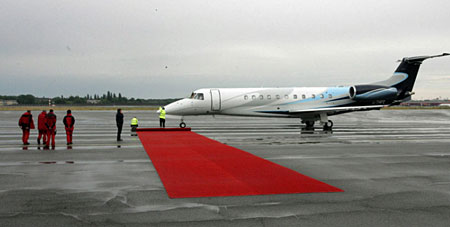
Having to hitch rides and borrow other people's jets when travelling abroad is embarrassing. Where's our national pride? Look, I know we can’t afford the £38.5bn rail upgrade, we are living through tough times. We may all be in it together, but the Queen flying to Germany on a State visit in a plane marked "G-THFC" - Tottenham Hotspur Football Club? Oh, come on! (The aircraft is owned by the Club’s chairman).
Yes, I know the pilot stuck the Royal Standard up outside the cockpit window as the plane taxied to a halt by the red carpet in Berlin, but it really couldn’t hide the sad reality. What has happened to our Nation's swank?
Yes, I know the pilot stuck the Royal Standard up outside the cockpit window as the plane taxied to a halt by the red carpet in Berlin, but it really couldn’t hide the sad reality. What has happened to our Nation's swank?
It all started to go wrong when the Royal Yacht Britannia was decommissioned in December of 1997 - one of the first acts of the Blair Government. The Royal Yacht had style as well as swank.
And it served a purpose. During its life, it made 696 foreign visits carrying not just the Royal Family, but acting as a mobile Exhibition Centre for British goods and services worldwide. It was the embodiment of the nation’s prestige.
But with the decommissioning of the Yacht, at least we had the Queen’s Flight, later the Royal Squadron, to convey the Monarch, her family, and members of the Government worldwide. But that is now a shadow of its former self. We no longer have dedicated aircraft capable of transatlantic or any other long haul flights yet it was the United Kingdom which first introduced dedicated air transport for the Head of State back in 1928.
How very different from other countries. I am not just talking about the fleet of beautifully liveried aircraft provided for the US Government which includes Air Force One. Or the Airbus A330-200 used by the President of the strike ridden French Republic. And needless to say, Angela Merkel and her government have access to eleven specialist aircraft each with dedicated communication equipment on board.
And it served a purpose. During its life, it made 696 foreign visits carrying not just the Royal Family, but acting as a mobile Exhibition Centre for British goods and services worldwide. It was the embodiment of the nation’s prestige.
But with the decommissioning of the Yacht, at least we had the Queen’s Flight, later the Royal Squadron, to convey the Monarch, her family, and members of the Government worldwide. But that is now a shadow of its former self. We no longer have dedicated aircraft capable of transatlantic or any other long haul flights yet it was the United Kingdom which first introduced dedicated air transport for the Head of State back in 1928.
How very different from other countries. I am not just talking about the fleet of beautifully liveried aircraft provided for the US Government which includes Air Force One. Or the Airbus A330-200 used by the President of the strike ridden French Republic. And needless to say, Angela Merkel and her government have access to eleven specialist aircraft each with dedicated communication equipment on board.
Greece - yes, Greece - has a Prime Ministerial jet operated by the Hellenic Air Force as does Morocco. I could go on.
Instead, the Queen arrives on a State visit in a Tottenham Hotspur aircraft while our Prime Minister and the rest of the Government either hire aircraft off British Airways or travel on scheduled routes. The latter makes good sense. But not always.
A senior minister has told me that he frequently has to hitch lifts with the Germans or others because there just aren’t the scheduled routes available when he attends conferences in oil states in the Caucuses. While money is tight, surely there has to be some limit to all this scrimping and saving? Do we have no national pride when it comes to foreign visits?
Instead, the Queen arrives on a State visit in a Tottenham Hotspur aircraft while our Prime Minister and the rest of the Government either hire aircraft off British Airways or travel on scheduled routes. The latter makes good sense. But not always.
A senior minister has told me that he frequently has to hitch lifts with the Germans or others because there just aren’t the scheduled routes available when he attends conferences in oil states in the Caucuses. While money is tight, surely there has to be some limit to all this scrimping and saving? Do we have no national pride when it comes to foreign visits?
When Tony Blair raised this, he was howled down with cries of ‘Blair Force One’ and no doubt I shall be accused of being foolish and insensitive in even writing about our national humiliation.
But Britain is the fifth largest economy in the world. We need to project our influence through soft power, and sometimes that does mean spending a little money. We are now the only country in the G20 without a dedicated jet aircraft for our Head of State and Head of Government.
So if we can’t reinstate the Royal Yacht, let’s at least introduce a dual purpose aircraft which can be used for HM Queen on Royal Visits and be used by the RAF on other occasions.
Let’s bring back some swank!
Michael Fabricant, Telegraph
But Britain is the fifth largest economy in the world. We need to project our influence through soft power, and sometimes that does mean spending a little money. We are now the only country in the G20 without a dedicated jet aircraft for our Head of State and Head of Government.
So if we can’t reinstate the Royal Yacht, let’s at least introduce a dual purpose aircraft which can be used for HM Queen on Royal Visits and be used by the RAF on other occasions.
Let’s bring back some swank!
Michael Fabricant, Telegraph
From: Keith Parker, Bowerhill, Wilts
Sent: Thursday, June 18, 2015 7:22 AM
Subject: Brize Norton Visit
Hi Tony,
Following our two previous successful trips to 1 AMW at RAF Brize Norton we have been asked back again.
The visit will take place on Wednesday 9th September 2015. If anyone is interested in having a day out at Brize please contact me on:
SPBR09055@blueyonder.co.uk soonest as we need to pass numbers to them before we can get started.
It doesn't matter if you have to cancel later, I understand that. We usually start with around 10 and end up with 5 or 6.
Thanks
Keith Parker
Sent: Thursday, June 18, 2015 7:22 AM
Subject: Brize Norton Visit
Hi Tony,
Following our two previous successful trips to 1 AMW at RAF Brize Norton we have been asked back again.
The visit will take place on Wednesday 9th September 2015. If anyone is interested in having a day out at Brize please contact me on:
SPBR09055@blueyonder.co.uk soonest as we need to pass numbers to them before we can get started.
It doesn't matter if you have to cancel later, I understand that. We usually start with around 10 and end up with 5 or 6.
Thanks
Keith Parker
RAAF to get two more tanker transports?
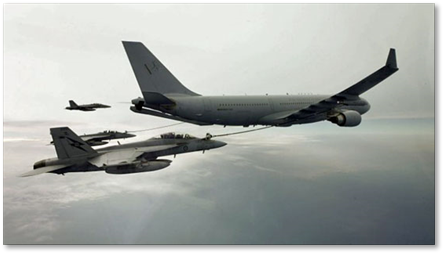
It appears likely that the Royal Australian Air Force (RAAF) is to acquire two more Airbus Defence A330-based multirole tanker transports (MRTT) to add to its current fleet of five, although no formal confirmation is yet available. A brief comment to this effect - since removed - appeared on the website of the Spanish Embassy in Canberra on 25 June. The embassy and an Airbus Defence spokesman subsequently declined any comment to IHS Jane's, as did the office of Minister of Defence Kevin Andrews.
The acquisition of an additional two MRTTs (KC-30A in Australian service) was informally forecast by then defence minister David Johnston in August 2014.
The acquisition of an additional two MRTTs (KC-30A in Australian service) was informally forecast by then defence minister David Johnston in August 2014.
IHS Jane's 360
From: Charles Collier, Ewhurst, Surrey
Sent: Sunday, June 14, 2015 3:15 PM
Subject: Transporting a Belvedere Helicopter from RAF Odiham to Weston
Hi Tony,
This is a first posting odd job given to me and a couple of colleagues.
Sent: Sunday, June 14, 2015 3:15 PM
Subject: Transporting a Belvedere Helicopter from RAF Odiham to Weston
Hi Tony,
This is a first posting odd job given to me and a couple of colleagues.
Although my first posting from Halton was to No 60 MU ARF (Aircraft Repair Flight) we were sometimes detached to other sections at the MU where there was a short-fall of manpower and in this case it was the MTF. They had the task of transporting a Bristol Belvedere Helicopter on an “Ark Royal” trailer from its base at RAF Odiham to the makers: the Bristol Aircraft Company’s site at Weston in Somerset.
As well as helping with the loading of the Belvedere onto the Ark Royal trailer we were about to take a journey from RAF Church Fenton in Yorkshire to RAF Odiham in Hampshire; load the helicopter on the trailer and then transport it to Weston, to the Bristol Aircraft Company’s site.
As well as helping with the loading of the Belvedere onto the Ark Royal trailer we were about to take a journey from RAF Church Fenton in Yorkshire to RAF Odiham in Hampshire; load the helicopter on the trailer and then transport it to Weston, to the Bristol Aircraft Company’s site.
In the picture you will see the Scammell Tractor which was the prime mover. We travelled behind in a Morris J2 passenger carrier with a warning about the length of the vehicles in line for those about to overtake. This was 1963 before the age of motorways so our trip took us down the old A1 festooned with roundabouts which seemed to be every 5 miles or so. This was because when we came to a stop at every roundabout we had very quickly take out a wooden beam from underneath the trailer and uncouple the rear axle so that the beam would then be placed in position for two of us to physically steer the rear quarter of the trailer around the roundabout without straddling its centre.
This antiquated procedure took some time. You can imagine this train of vehicles trundling to a stop at the approach to a roundabout. We wait for the following traffic to disperse then, as I said, unhitch the trailers rear axle for manual steering, place the beam in its attachment and then give the driver a signal that we were ready to go. All this took time which when I think back must have taken about 15 minutes. Multiply that by the number of roundabouts you can see why we took such a long time on the road.
This working journey must have taken about a week to 10 days. Every night we were destined to find accommodation where we parked the tractor / trailer in a town. We stayed at B&B’s as no RAF camp transit facilities were on the route so we were granted nights stop funding in the towns. All this was fine until we got to Weston were we spent the night at RAF Locking.
The return journey was a different route as we then left RAF Locking heading back to camp at Church Fenton. I remember we travelled south of Bristol then along that routing in a north easterly direction until we met the A4 where we then continued along this, taking days to do it. I remember one night stop at Marlborough in Wiltshire which has the wide high-street with parking in the centre - this was where the tractor/trailer was conveniently parked overnight.
Going through the various county's police areas of responsibility they were sometimes insistent in providing a police escort as shown in the picture.
Well, it made a pleasant change of job for a brief period and interesting to find out how other people were employed in the RAF!
Cheers, Chas
The return journey was a different route as we then left RAF Locking heading back to camp at Church Fenton. I remember we travelled south of Bristol then along that routing in a north easterly direction until we met the A4 where we then continued along this, taking days to do it. I remember one night stop at Marlborough in Wiltshire which has the wide high-street with parking in the centre - this was where the tractor/trailer was conveniently parked overnight.
Going through the various county's police areas of responsibility they were sometimes insistent in providing a police escort as shown in the picture.
Well, it made a pleasant change of job for a brief period and interesting to find out how other people were employed in the RAF!
Cheers, Chas
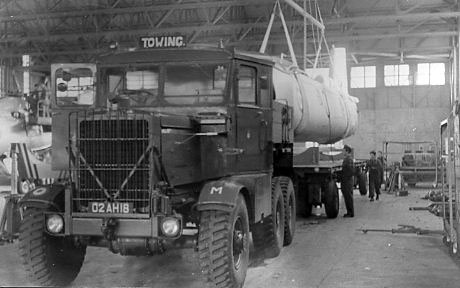
UK Celebrates Armed Forces Day 2015
From: Michael Hughes, Ipswich, QLD
Sent: Thursday, June 25, 2015 7:36 PM
Subject: Question re ‘wagon wheel’ origins
Hi Tony,
I’m curious to know how the ‘wagon wheel’ emblem became associated with Movers - does anybody know?
Cheers
Mick
Sent: Thursday, June 25, 2015 7:36 PM
Subject: Question re ‘wagon wheel’ origins
Hi Tony,
I’m curious to know how the ‘wagon wheel’ emblem became associated with Movers - does anybody know?
Cheers
Mick
Farewell to the RNZAF Huey
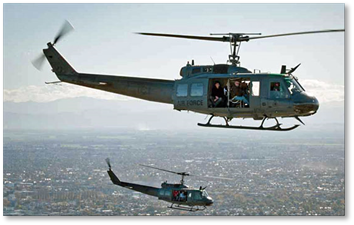
May was a special month for the Iroquois and 3 SQN as the Air Force took three Hueys to locations around New Zealand, giving veterans the opportunity to take one last flight before the Hueys are withdrawn from service. The Iroquois went to Blenheim, Christchurch, Napier, Tauranga, Auckland and Wellington. At each location the large turnout of veterans was proof of how much the Huey means to them. In some cases this was the first time since the early 1970s that the veterans had flown on the aircraft and for many veterans it was an emotional experience. FLTLT Micko Shaw says the opportunity to engage with the veterans was very rewarding. “You could see how thrilled they were to be able to go flying and it was a pleasure for us to be able to take them up. They had the biggest smiles on their faces and it brought back lots of memories for them. It was great to hear their stories.”
The fine weather meant many residents were able to see the Hueys flying over their town. It was a sight that was much talked about on the Air Force Facebook page and reinforced how iconic the helicopters are in New Zealand.
SQNLDR Stu Pearce was pleased to have the opportunity to meet up with veterans of past operations to Vietnam, Borneo, Malaya, as well as more recent operations to East Timor. “For members of the Iroquois section to be able to talk with these veterans and hear their stories gave us all a sense of the importance of the Huey, its legacy and what it means to New Zealanders. The overall feeling amongst the maintenance team was one of pride in being able to give something back to past servicemen and women and pride in the contribution the Huey has made to New Zealand over the years.”
Perhaps most well-known for their role in the Vietnam War, the Hueys have been a stalwart of Defence Force operations for almost 50 years. The helicopters have played a vital role in search and rescue, the Canterbury earthquake recovery, assisted with the New Zealand Police annually and regularly served in the Pacific, Antarctica and war zones around the world.
An official retirement function for the Iroquois was held at Base Ohakea at the end of May. The aircraft will stop flying on 1 July, with the roles and duties previously carried out by the Iroquois undertaken by the NH90 and A109 helicopters.
NZ Air Force News
SQNLDR Stu Pearce was pleased to have the opportunity to meet up with veterans of past operations to Vietnam, Borneo, Malaya, as well as more recent operations to East Timor. “For members of the Iroquois section to be able to talk with these veterans and hear their stories gave us all a sense of the importance of the Huey, its legacy and what it means to New Zealanders. The overall feeling amongst the maintenance team was one of pride in being able to give something back to past servicemen and women and pride in the contribution the Huey has made to New Zealand over the years.”
Perhaps most well-known for their role in the Vietnam War, the Hueys have been a stalwart of Defence Force operations for almost 50 years. The helicopters have played a vital role in search and rescue, the Canterbury earthquake recovery, assisted with the New Zealand Police annually and regularly served in the Pacific, Antarctica and war zones around the world.
An official retirement function for the Iroquois was held at Base Ohakea at the end of May. The aircraft will stop flying on 1 July, with the roles and duties previously carried out by the Iroquois undertaken by the NH90 and A109 helicopters.
NZ Air Force News
From: David Powell, Princes Risborough
Sent: Friday, June 26, 2015 8:27 AM
Subject: Turbulence (aka Lumpy Clouds)
Hi Tony, Bumpy Rides
One of the scariest trips I ever endured with F Team was also one of the shortest. A low level hop from Colerne to Keevil or it may have been Keevil to Colerne. No doubt Clive Price [the fat Welshman who used to drink with Bob Turner] will put the record straight. My battered log book just records: 14 Nov 67, C130E (USAF) No 7845, P1 Col Reeves, 37th TCS Colerne-Keevil, Keevil-Colerne; nightstop Colerne; 15 Nov, C130E (USAF) No 7793, P1 Maj Reeves, 37th TCS Colerne-Keevil, Keevil-Colerne; Jigsaw 4/5.
The story behind task Jigsaw 4/5 is that this was a trial load of a new (105mm?) towed field gun. However, because the load had not been cleared for the new RAF C130s, the trial would be carried out in a USAF C130E using a proposed tie down scheme. It might even have been that the gun was an American product, and part of a potential NATO standardisation procurement deal. Anyway, the gun was duly winched in and chained down as per plan.
With F Team on board we duly set off low level. Hardly had the wheels come up and we started bouncing around. As did the gun! Despite being chained down, I swear that there was daylight between the tyres on the main gun carriage/chassis wheels (or whatever the technical name is) and the aircraft floor.
Also, I should add that there was now even less clearance between the oscillating tip of the large gun barrel and the aircraft cabin roof. So we unstrapped from our para side seats and dived/hung onto the load, while adding a cat’s cradle of more chains and tensioners in the bucking C130 until the load appeared to be properly subdued.
From the log book, I can only assume that we had a, hopefully, uneventful rerun the following day with a revised tie-down scheme.
Meanwhile, I note that Colonel Reeves had delegated the task to one of his subordinates, I wonder why?
Happy interesting days.
David Powell
F Team 1967-69
Sent: Friday, June 26, 2015 8:27 AM
Subject: Turbulence (aka Lumpy Clouds)
Hi Tony, Bumpy Rides
One of the scariest trips I ever endured with F Team was also one of the shortest. A low level hop from Colerne to Keevil or it may have been Keevil to Colerne. No doubt Clive Price [the fat Welshman who used to drink with Bob Turner] will put the record straight. My battered log book just records: 14 Nov 67, C130E (USAF) No 7845, P1 Col Reeves, 37th TCS Colerne-Keevil, Keevil-Colerne; nightstop Colerne; 15 Nov, C130E (USAF) No 7793, P1 Maj Reeves, 37th TCS Colerne-Keevil, Keevil-Colerne; Jigsaw 4/5.
The story behind task Jigsaw 4/5 is that this was a trial load of a new (105mm?) towed field gun. However, because the load had not been cleared for the new RAF C130s, the trial would be carried out in a USAF C130E using a proposed tie down scheme. It might even have been that the gun was an American product, and part of a potential NATO standardisation procurement deal. Anyway, the gun was duly winched in and chained down as per plan.
With F Team on board we duly set off low level. Hardly had the wheels come up and we started bouncing around. As did the gun! Despite being chained down, I swear that there was daylight between the tyres on the main gun carriage/chassis wheels (or whatever the technical name is) and the aircraft floor.
Also, I should add that there was now even less clearance between the oscillating tip of the large gun barrel and the aircraft cabin roof. So we unstrapped from our para side seats and dived/hung onto the load, while adding a cat’s cradle of more chains and tensioners in the bucking C130 until the load appeared to be properly subdued.
From the log book, I can only assume that we had a, hopefully, uneventful rerun the following day with a revised tie-down scheme.
Meanwhile, I note that Colonel Reeves had delegated the task to one of his subordinates, I wonder why?
Happy interesting days.
David Powell
F Team 1967-69
2 Air Movements RCAF changes command
Members of 2 Air Movements Squadron have bid a final farewell to their leader of three years and a member of the family.
Thursday morning marked the change of command ceremony where Lt.-Col. Deborah Graitson officially relinquished control of the squadron to incoming commanding officer (CO), Lt.-Col. Paul Young.
Graitson joined the Royal Canadian Air Force (RCAF) in 1985 as a traffic technician. She’s completed postings in Trenton, North Bay and Moose Jaw. She’s led deployments in Norway, Bosnia, Turkey, Macedonia and all over the United States, as well as served at National Defence Headquarters and Canadian Special Operations Forces Command (CANSOFCOM) Headquarters in Ottawa, over the course of her 30-year career.
She was promoted to her current rank in 2012 and now is returning to Ottawa to tackle new challenges as the J4 at Canadian Materiel Support Group (CMSG). But she will not forget her time at CFB Trenton.
Reflecting on the last few years here, Graitson was saddened, she said Thursday. “I’m so proud to have had you all as extended family,” she told members of the squadron during her address at the ceremony. I’ve proudly watched you all advance and grow, some of you during very tough times. I’m deeply saddened to say farewell today.”
The RCAF reports recent statistics indicate an average of 23 million pounds of freight and 42,000 passengers are processed through 2 Air Movements Squadron annually. “And not once did you guys not make me proud,” Graitson told her squad.
With Graitson at the helm since 2012, the squadron has been involved in missions in Mali, in the closure of Op ATTENTION in Afghanistan and in DART deployments to the Philippines. In 2013 and 2014, squadron personnel were deployed for more than 12,000 days on missions and operations. “Thank you sincerely, for always following your motto of never unprepared at home and abroad,” Graitson said.
Thursday morning marked the change of command ceremony where Lt.-Col. Deborah Graitson officially relinquished control of the squadron to incoming commanding officer (CO), Lt.-Col. Paul Young.
Graitson joined the Royal Canadian Air Force (RCAF) in 1985 as a traffic technician. She’s completed postings in Trenton, North Bay and Moose Jaw. She’s led deployments in Norway, Bosnia, Turkey, Macedonia and all over the United States, as well as served at National Defence Headquarters and Canadian Special Operations Forces Command (CANSOFCOM) Headquarters in Ottawa, over the course of her 30-year career.
She was promoted to her current rank in 2012 and now is returning to Ottawa to tackle new challenges as the J4 at Canadian Materiel Support Group (CMSG). But she will not forget her time at CFB Trenton.
Reflecting on the last few years here, Graitson was saddened, she said Thursday. “I’m so proud to have had you all as extended family,” she told members of the squadron during her address at the ceremony. I’ve proudly watched you all advance and grow, some of you during very tough times. I’m deeply saddened to say farewell today.”
The RCAF reports recent statistics indicate an average of 23 million pounds of freight and 42,000 passengers are processed through 2 Air Movements Squadron annually. “And not once did you guys not make me proud,” Graitson told her squad.
With Graitson at the helm since 2012, the squadron has been involved in missions in Mali, in the closure of Op ATTENTION in Afghanistan and in DART deployments to the Philippines. In 2013 and 2014, squadron personnel were deployed for more than 12,000 days on missions and operations. “Thank you sincerely, for always following your motto of never unprepared at home and abroad,” Graitson said.
The squadron provides safe and efficient movement of passengers, baggage, freight and mail originating, staging through or terminating in Trenton in support of Canadian Armed Forces operations and exercises around the world.
Air movements members have also taught Graitson a “great deal about people.” And for that she’ll be forever grateful, she said.
Before handing over her squad to Young, Graitson wished her troops more future success and thanked the many who have been a part of her success including her husband, David, for his endless patience, and her many mentors including 8 Wing Commander Brig.-Gen. David Lowthian.
Lowthian also expressed his gratitude Thursday for Graitson. “We’ve been extremely fortunate to have Debbie at the helm,” he said. The readiness levels of this unit are exceptional now and they’ve all beamed with pride with you as their leader,” he continued. And while it was sad to say goodbye, Lowthian knows Young is a capable and focused leader to succeed Graitson. He warmly welcomed the new CO at the parade.
Air movements members have also taught Graitson a “great deal about people.” And for that she’ll be forever grateful, she said.
Before handing over her squad to Young, Graitson wished her troops more future success and thanked the many who have been a part of her success including her husband, David, for his endless patience, and her many mentors including 8 Wing Commander Brig.-Gen. David Lowthian.
Lowthian also expressed his gratitude Thursday for Graitson. “We’ve been extremely fortunate to have Debbie at the helm,” he said. The readiness levels of this unit are exceptional now and they’ve all beamed with pride with you as their leader,” he continued. And while it was sad to say goodbye, Lowthian knows Young is a capable and focused leader to succeed Graitson. He warmly welcomed the new CO at the parade.
This is Young’s first posting to Trenton. But he’s worked all over the country as well as been selected for two exchange assignments in the United States, serving in Hawaii and Illinois. “I’ll actually be moving from Belleville, IL., to Belleville, Ont.,” he laughed. He and his family are looking forward to getting to know the area, he added.
Young has been deployed all over the globe and served in Rwanda, the former Republic of Yugoslavia, Italy and Golan Heights. He joined the forces as a direct entry officer in 1988. Young thanked Graitson for her outstanding dedication and leadership.
With operations ongoing currently in Iraq, Syria and Eastern Europe, for examples, there’s nothing the new CO looks forward to more than working his command team to lead “this fine group of professionals” in providing world-class support to airlift operations and other logistics activities.
Story: Bellevillle Intelligencer / Photographs: David Amberley
Young has been deployed all over the globe and served in Rwanda, the former Republic of Yugoslavia, Italy and Golan Heights. He joined the forces as a direct entry officer in 1988. Young thanked Graitson for her outstanding dedication and leadership.
With operations ongoing currently in Iraq, Syria and Eastern Europe, for examples, there’s nothing the new CO looks forward to more than working his command team to lead “this fine group of professionals” in providing world-class support to airlift operations and other logistics activities.
Story: Bellevillle Intelligencer / Photographs: David Amberley
New members joining us recently are:


RAF
RCAF
Alex Murphy-Brown, High Wycombe, Bucks, UK
Doc MacKenzie, Pictou Landing, NS, Canada
Welcome to the OBA!
From: Frank Lightfoot, Glasgow
Sent: Sunday, June 07, 2015 3:20 PM
Subject: Len Bowen’s photo and some waffle
Hi Tony,
Reading your comments and Len Bowen’s photo brought back some distant memories of MAM's days in the Far East.
Our bungalow in Serangoon, Singapore, became a stopover for UKMAMS on the way out and subsequent return to blighty. June used to come back from the wives’ club to find the team sitting on the patio wall. Many a good get together was held. I remember Chas Cormack falling off of the wall into the monsoon drain (nished as a pewt) and the Changi Splash!
Vick King was our CO. Len was replaced by Colin Heithus and Pete Kingwill was the other team leader. Pete passed away a while back.
Most of my photos have been lost or fallen to bits; I'll have a good look to see what I uncover.
Take care
Frank
Sent: Sunday, June 07, 2015 3:20 PM
Subject: Len Bowen’s photo and some waffle
Hi Tony,
Reading your comments and Len Bowen’s photo brought back some distant memories of MAM's days in the Far East.
Our bungalow in Serangoon, Singapore, became a stopover for UKMAMS on the way out and subsequent return to blighty. June used to come back from the wives’ club to find the team sitting on the patio wall. Many a good get together was held. I remember Chas Cormack falling off of the wall into the monsoon drain (nished as a pewt) and the Changi Splash!
Vick King was our CO. Len was replaced by Colin Heithus and Pete Kingwill was the other team leader. Pete passed away a while back.
Most of my photos have been lost or fallen to bits; I'll have a good look to see what I uncover.
Take care
Frank
Saturday 27th June, thousands of people across the country celebrated the men and women of the Armed Forces, past and present, at more than 150 events to mark the seventh annual Armed Forces Day.
The Duke of York took the salute on the parade route on behalf of The Queen and Royal Family, as the world famous Red Arrows roared over the square in tribute.
Afternoon celebrations continued at Stoke Park with a variety of military displays including a Royal Air Force GR4 Tornado flypast. Visitors also enjoyed a Sea King search and rescue demonstration, Spitfires and Hurricaines from the RAF Battle of Britain memorial Flight and a Swordfish biplane from the Royal Navy Historic Flight.
In addition, crowds of an estimated 60,000 were treated to three parachute displays from the Royal Navy Raiders, the Army Red Devils and the RAF Falcons, as well as the Royal Signals White Helmet motorbike display team on the ground.
The Red Arrows took to the skies again as the military celebrations drew to a close accompanied by a tri-service group of military bands made of Her Majesty's Royal Marines, Portsmouth, the Band of the Grenadier Guards, and the Central Band of the Royal Air Force.
Gov.uk / Forces TV
The Duke of York took the salute on the parade route on behalf of The Queen and Royal Family, as the world famous Red Arrows roared over the square in tribute.
Afternoon celebrations continued at Stoke Park with a variety of military displays including a Royal Air Force GR4 Tornado flypast. Visitors also enjoyed a Sea King search and rescue demonstration, Spitfires and Hurricaines from the RAF Battle of Britain memorial Flight and a Swordfish biplane from the Royal Navy Historic Flight.
In addition, crowds of an estimated 60,000 were treated to three parachute displays from the Royal Navy Raiders, the Army Red Devils and the RAF Falcons, as well as the Royal Signals White Helmet motorbike display team on the ground.
The Red Arrows took to the skies again as the military celebrations drew to a close accompanied by a tri-service group of military bands made of Her Majesty's Royal Marines, Portsmouth, the Band of the Grenadier Guards, and the Central Band of the Royal Air Force.
Gov.uk / Forces TV
The UK’s Largest Solar Farm - Lyneham

From: Andrew Gell, Paphos Int’l
Sent: Friday, June 26, 2015 12:15 PM
Subject: Turbulence (aka Lumpy Clouds)
Dear Tony
I don't know about lumpy clouds, but I do recall a very lumpy landing on a MAMS route in the back of a C130 trainer that was flagging Rome. Afterwards, I went up to the flight deck and asked the training Captain whether he or the trainee had flown the landing. I clearly remember his reply to this day, "We both were; he was pushing and I was pulling!"
Best wishes,
Andy Gell
(From Paphos airport on way home from a holiday in Cyprus, coincidently during RAF Akrotiri's 60th Anniversary Year)
Sent: Friday, June 26, 2015 12:15 PM
Subject: Turbulence (aka Lumpy Clouds)
Dear Tony
I don't know about lumpy clouds, but I do recall a very lumpy landing on a MAMS route in the back of a C130 trainer that was flagging Rome. Afterwards, I went up to the flight deck and asked the training Captain whether he or the trainee had flown the landing. I clearly remember his reply to this day, "We both were; he was pushing and I was pulling!"
Best wishes,
Andy Gell
(From Paphos airport on way home from a holiday in Cyprus, coincidently during RAF Akrotiri's 60th Anniversary Year)
From: Syd Avery, Guardamar del Segura
Sent: Friday, June 26, 2015 1:36 PM
Subject: Turbulence (aka Lumpy Clouds)
So there we were, trundling sort of northish from Sydney to Kuala Lumpur in our trusty DC8 with a load of racehorses and attendant grooms. Whump! - Lumpy air!
We dropped a yard or two. One of the grooms called for me to go to the rear of the cargo compartment as there was a slight problem. As we descended, Dobbin ascended and moved slightly towards the tail (ours not his), and ended up with his front end outside the pen, rear end inside the pen, front hooves just clear of the floor with the whites of his eyes showing. We deduced that this was one frightened, not very happy Dobbin.
We managed to calm him and began working out how to get him back where he should be when, Whump! - Crash! - down we went again. The Gods were with us, as, when we picked ourselves up, we saw that Dobbin, bless, had been thrown back in his pen! It took the grooms some time to calm him down again.
The poor animal showed what his thoughts on flying were when we got to KL. He escaped from his handler and the airport had to be closed for half an hour until he was caught. I believe that on race days, his groom showed him a model aeroplane in the hope it would help his winning chances!
Regards,
Syd
Sent: Friday, June 26, 2015 1:36 PM
Subject: Turbulence (aka Lumpy Clouds)
So there we were, trundling sort of northish from Sydney to Kuala Lumpur in our trusty DC8 with a load of racehorses and attendant grooms. Whump! - Lumpy air!
We dropped a yard or two. One of the grooms called for me to go to the rear of the cargo compartment as there was a slight problem. As we descended, Dobbin ascended and moved slightly towards the tail (ours not his), and ended up with his front end outside the pen, rear end inside the pen, front hooves just clear of the floor with the whites of his eyes showing. We deduced that this was one frightened, not very happy Dobbin.
We managed to calm him and began working out how to get him back where he should be when, Whump! - Crash! - down we went again. The Gods were with us, as, when we picked ourselves up, we saw that Dobbin, bless, had been thrown back in his pen! It took the grooms some time to calm him down again.
The poor animal showed what his thoughts on flying were when we got to KL. He escaped from his handler and the airport had to be closed for half an hour until he was caught. I believe that on race days, his groom showed him a model aeroplane in the hope it would help his winning chances!
Regards,
Syd
From: Clive Price, Brecon
Sent: Sunday, June 28, 2015 1:22 PM
Subject: Turbulence
Some Ghanaian soldiers had been on an exchange training in Scotland. We went up there by Britannia, loaded them on and proceeded to take them home to Africa. An hour out from the African coast we hit an air pocket and dropped a few hundred feet (I don't do metric!).
All of our passengers were screaming "WOO HOO!" and the rattle of rosary beads in a hundred hands drowned out the sound of the engines.
Later we found out that the aircrew had decided to grab our hotel rooms and at midnight we were still looking for a hotel.
Well, that's life as they say.
Cheers
Taff Price
Sent: Sunday, June 28, 2015 1:22 PM
Subject: Turbulence
Some Ghanaian soldiers had been on an exchange training in Scotland. We went up there by Britannia, loaded them on and proceeded to take them home to Africa. An hour out from the African coast we hit an air pocket and dropped a few hundred feet (I don't do metric!).
All of our passengers were screaming "WOO HOO!" and the rattle of rosary beads in a hundred hands drowned out the sound of the engines.
Later we found out that the aircrew had decided to grab our hotel rooms and at midnight we were still looking for a hotel.
Well, that's life as they say.
Cheers
Taff Price
"Bunga Bunga!"
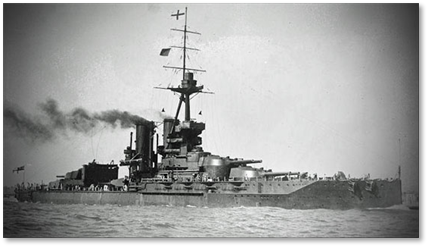
In the years before World War I, Britain had the most powerful navy in the world. And the HMS Dreadnought, armed with ten large guns and powered by a steam engine, was the pride of the fleet. Considered the superweapon of its day, the huge battleship lay anchored under the tightest security in Weymouth. Few outside of the Navy's top officers had ever stepped on board, much less toured its "top-secret" state-of-the-art weaponry.
On February 10, 1910, Sir William May, the ship's captain, received a telegram from the Foreign Office, signed by Under-Secretary Sir Charles Hardinge, announcing the impending arrival of the emperor of Abyssinia and his court in England. The emperor was to receive the royal treatment, including a tour of the HMS Dreadnought.
On February 10, 1910, Sir William May, the ship's captain, received a telegram from the Foreign Office, signed by Under-Secretary Sir Charles Hardinge, announcing the impending arrival of the emperor of Abyssinia and his court in England. The emperor was to receive the royal treatment, including a tour of the HMS Dreadnought.
The captain immediately ordered his officers and crew to prepare to greet the emperor with all due pomp and circumstance. Guns were polished, decks swabbed and uniforms washed and pressed in anticipation of the royal tour.
But the telegram was a fake - it was sent by a practical joker named Horace de Vere Cole. A few days later, he and five co-conspirators (including author Virginia Woolf and her brother) blackened their faces and hands with burnt cork, glued false beards to their chins, donned long red robes topped with makeshift turbans (all rented), and took a cab to London's Paddington Station. Brazenly declaring that he was a state official named "Herbert Cholmondley," Cole talked the stationmaster into giving them a VIP train to Weymouth, where the delegation was met with a full honour guard and brass band.
An Abyssinian flag couldn't be found (no one knew what one looked like), so one from Zanzibar was used instead. And the band played the Zanzibar national anthem, since that was the only African anthem they knew (the pranksters didn't know the difference). The Navy had no translator either. Fortunately, the delegation supplied their own, and his translations were so eloquent that none of the navy officers noticed that the language spoken by the "Abyssinians" bore a a striking resemblance to fractured Latin. As they were shown all of the ship's accoutrements, they shouted, "Bunga Bunga!" in approval of everything they saw.
But the telegram was a fake - it was sent by a practical joker named Horace de Vere Cole. A few days later, he and five co-conspirators (including author Virginia Woolf and her brother) blackened their faces and hands with burnt cork, glued false beards to their chins, donned long red robes topped with makeshift turbans (all rented), and took a cab to London's Paddington Station. Brazenly declaring that he was a state official named "Herbert Cholmondley," Cole talked the stationmaster into giving them a VIP train to Weymouth, where the delegation was met with a full honour guard and brass band.
An Abyssinian flag couldn't be found (no one knew what one looked like), so one from Zanzibar was used instead. And the band played the Zanzibar national anthem, since that was the only African anthem they knew (the pranksters didn't know the difference). The Navy had no translator either. Fortunately, the delegation supplied their own, and his translations were so eloquent that none of the navy officers noticed that the language spoken by the "Abyssinians" bore a a striking resemblance to fractured Latin. As they were shown all of the ship's accoutrements, they shouted, "Bunga Bunga!" in approval of everything they saw.
There were a few anxious moments. One was when the pranksters realised one of the Navy officers knew Woolf, but the officer never caught on. Another came when their interpreter sneezed and almost blew off his whiskers. Again, no one noticed. Weather almost sank the prank too; rain began to fall as the delegation arrived at the Dreadnought - Cole managed to talk their way onto a lower deck just as their makeup started to run.
Finally, Cole decided it was time to get out. They refused lunch (they weren't sure what dietary restrictions might go along with their made-up religion) and left quickly on the excuse that there were no prayer mats for their daily devotionals.
The delegation was given a military escort back to their train. Still in disguise and under Naval supervision, the "Abyssinians" requested that waiters serving them dinner wear white gloves (the train stopped and was held up in Reading to purchase the gloves).
Finally, Cole decided it was time to get out. They refused lunch (they weren't sure what dietary restrictions might go along with their made-up religion) and left quickly on the excuse that there were no prayer mats for their daily devotionals.
The delegation was given a military escort back to their train. Still in disguise and under Naval supervision, the "Abyssinians" requested that waiters serving them dinner wear white gloves (the train stopped and was held up in Reading to purchase the gloves).
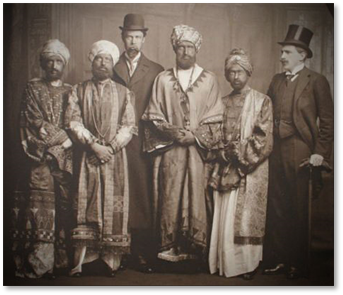
Five days later a photograph appeared in the Daily Mirror, showing the "Abyssinian" delegation with their Naval hosts. In the accompanying article, Cole exposed the hoax and ridiculed the Navy for being so gullible. All over London, sailors were harassed with cries of "Bunga Bunga!"
The Admiralty were furious, but its attempts to charge Cole with treason (the delegation had seen top-secret areas of the ship) was hooted down in Parliament and the press. After all, as people pointed out, the only "treasonous" thing they'd done was to make the Admiralty and its officers look like fools. Besides, the only actual crime committed was sending a telegram under a false name. The Navy decided not to press charges, but still felt that somebody had to be punished. As the pranksters were all upper class, they could get away with a symbolic act to settle the dispute as gentlemen. Naval officers visited Cole and gave him six symbolic taps on the buttocks with a cane. Cole insisted he be allowed to do the same to the officers. Amazingly, the officers agreed.
The Admiralty were furious, but its attempts to charge Cole with treason (the delegation had seen top-secret areas of the ship) was hooted down in Parliament and the press. After all, as people pointed out, the only "treasonous" thing they'd done was to make the Admiralty and its officers look like fools. Besides, the only actual crime committed was sending a telegram under a false name. The Navy decided not to press charges, but still felt that somebody had to be punished. As the pranksters were all upper class, they could get away with a symbolic act to settle the dispute as gentlemen. Naval officers visited Cole and gave him six symbolic taps on the buttocks with a cane. Cole insisted he be allowed to do the same to the officers. Amazingly, the officers agreed.
Uncle John's Bathroom Reader
Breaking News - 29 June 2015 - RAF C17 Leaves for Tunisia
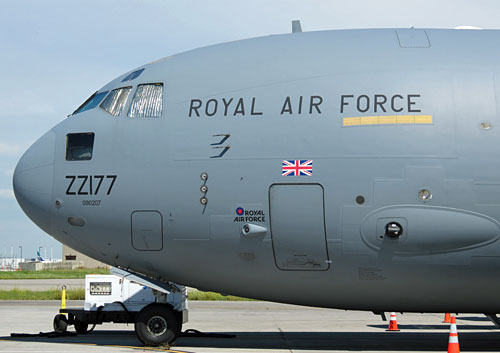
A Royal Air Force (RAF) C-17 is en route to Tunisia to evacuate critically-injured British nationals on behalf of the UK Government. The flight was requested by the Foreign and Commonwealth Office, who are coordinating the evacuation after the terrorist attack in Sousse on Friday, 26 June.
The aircraft left RAF Brize Norton at just after midday today [Monday, 29 June] and has been specially modified for this mission, allowing it to carry additional stretchered patients. The RAF is due to bring back four patients injured in the terrorist attack if they are fit to travel.
Two highly-trained RAF Critical Care Air Support Teams are onboard, including Consultant Anaesthetists, an Anaesthetic Registrar and intensive care nurses. The team will give the patients the best possible care until they arrive back in the UK.
The aircraft left RAF Brize Norton at just after midday today [Monday, 29 June] and has been specially modified for this mission, allowing it to carry additional stretchered patients. The RAF is due to bring back four patients injured in the terrorist attack if they are fit to travel.
Two highly-trained RAF Critical Care Air Support Teams are onboard, including Consultant Anaesthetists, an Anaesthetic Registrar and intensive care nurses. The team will give the patients the best possible care until they arrive back in the UK.
The C-17’s large size allows it to carry essential medical kit while offering medical teams 365 degree access to patients, with good lighting and lots of workspace.
Squadron Leader Adam Manson, helping to coordinate the aeromedical evacuation effort, said: “The C-17 allows us to bring back multiple critically-injured patients safely and quickly on one aircraft. Having medically-trained personnel onboard also helps us organise the patients’ onward moves to the appropriate major trauma centres around the UK. The RAF is well-versed in aeromedical missions, having performed the role in Afghanistan. The injuries the patients have sustained are very similar to the types of injuries the military can face and the teams we’ve sent are used to treating patients on aircraft - they’re in the best possible hands. We’re also working with NHS England to arrange the patients’ onward moves once they’re back in the UK to take each person to the best hospital in their area for their needs.”
For further advice and information following the terrorist incident in Tunisia, including travel advice and concerns for those who may be involved, see the FCO travel advice page - https://www.gov.uk/foreign-travel-advice/tunisia.
raf.mod.uk
Squadron Leader Adam Manson, helping to coordinate the aeromedical evacuation effort, said: “The C-17 allows us to bring back multiple critically-injured patients safely and quickly on one aircraft. Having medically-trained personnel onboard also helps us organise the patients’ onward moves to the appropriate major trauma centres around the UK. The RAF is well-versed in aeromedical missions, having performed the role in Afghanistan. The injuries the patients have sustained are very similar to the types of injuries the military can face and the teams we’ve sent are used to treating patients on aircraft - they’re in the best possible hands. We’re also working with NHS England to arrange the patients’ onward moves once they’re back in the UK to take each person to the best hospital in their area for their needs.”
For further advice and information following the terrorist incident in Tunisia, including travel advice and concerns for those who may be involved, see the FCO travel advice page - https://www.gov.uk/foreign-travel-advice/tunisia.
raf.mod.uk
That's it for this issue
If you're reaading this and are not already a listed member, fill out an application (free) at:
http://ukmamsoba.org/members.htm
Tony
ukmamsoba@gmail.com
If you're reaading this and are not already a listed member, fill out an application (free) at:
http://ukmamsoba.org/members.htm
Tony
ukmamsoba@gmail.com







